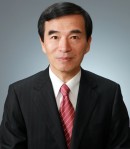
Plenary Lecture
Manipulation of Human Genome Using Completely Chemistry-Based DNA Cutter

Professor Makoto Komiyama
Life Science Center of Tsukuba Advanced Research Alliance
University of Tsukuba
Japan
E-mail: komiyama@tara.tsukuba.ac.jp
Abstract: The current molecular biology is primarily based on site-selective DNA scission by restriction enzymes. However, site-specificity of naturally occurring restriction enzymes is too low to manipulate huge DNA. In order to solve this problem, we recently developed completely chemistry-based tools (Artificial Restriction DNA Cutter; ARCUT) which cut double-stranded DNA at desired site. These tools are composed of (1) Ce(IV)/EDTA complex as molecular scissors to hydrolyze the phosphodiester linkages and (2) two pseudo-complementary PNA strands. The site of selective scission is simply determined by Watson-Crick rule, and the site-specificity is freely modulated by changing the lengths of PNA strands.
With the use of ARCUT, the whole genome of human beings (composed of 3 x 109 base-pairs) was selectively cut at one target site. Importantly, analogous sites, which are different from the target site only by one or two base-pairs, were hardly cut and thus specificity of the scission was sufficiently high. The scission fragments were easily combined with foreign DNAs using ligase. Furthermore, targeted homologous recombination in human cells was notably promoted by selective scission of the genome at the corresponding site. Thus, a site in a gene in human genome was converted to a predetermined sequence, when ARCUT was introduced into human cells together with the corresponding homologous DNA fragments. Various applications of ARCUT to molecular biology and biotechnology are strongly indicated.
Brief Biography of the Speaker: Makoto Komiyama graduated from the University of Tokyo in 1970, and got his Ph.D. from the same University in 1975. After spending four years at Northwestern University (Illinois, USA) as a postdoctoral fellow, he became an assistant professor of the University of Tokyo, and then an associate professor of University of Tsukuba. In 1991, he became a professor of the University of Tokyo. In 2012, he moved from the University of Tokyo to Life Science Center of Tsukuba Advanced Research Alliance, University of Tsukuba. His main research area is bioorganic and bioinorganic chemistry, and the number of original papers is more than 500. He received Awards for Young Scientist from the Chemical Society of Japan, Japan IBM Science Award, Award from the Rare Earth Society of Japan, Inoue Prize for Science, Award from Cyclodextrin Society of Japan, The Award of the Society of Polymer Science, The Chemical Society of Japan Award, and SPSJ Award for Outstanding Achievement in Polymer Science and Technology, and others.